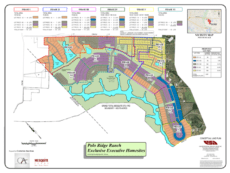
Public Infrastructure and Services Analyses
Public Finance Program Strategies and Implementation
DTA Staff Is Experienced In The Preparation And Implementation Of Financing Strategies
and plans to fund public facilities and services for both existing land development and newly developing areas. Debt financing programs implemented by DTA range from bond issuances secured by a municipality’s General Fund to debt financings that are non-recourse to a municipality and secured instead by a stream of special taxes, assessments, enterprise fund revenues, or other income streams. DTA specializes in the creative use of non-recourse financing programs to maximize the availability of capital early in the development process and ensure the timely construction of public facilities wherever new development is occurring. This may include the use of builder bonds, lease revenue bonds, senior/subordinate and variable interest rate debt instruments, bridge financings, sureties, impact fee revenue bonds, bond pools, and other alternative debt structuring techniques.
DTA's Financing Strategies Are Quantitative, Specific, and Prepared For Implementation.
In contrast, strategies prepared by other firms are often limited in scope and largely descriptive in nature. DTA provides detailed revenue projections from all available sources and matches feasible revenue streams with the costs for all public improvements and services projected to be required in future years. Since 1985, DTA has been involved in the formation of more than 2,000 public finance districts and funding programs, with total bond authorizations exceeding $60 billion. These districts and funding programs have financed roads, sewer and water facilities, drainage and flood control improvements, police and fire protection facilities, schools, parks, open space, wildlife habitat, community and senior centers, and the services related to the maintenance and operations of these types of facilities.
Public Financing Districts and Mechanisms Implemented by DTA
- Bridge and Thoroughfare Districts (California);
- Business Improvement Districts (National);
- Certificates of Participation (National);
- Community Development Districts (Florida);
- Community Facilities Districts (California, Arizona, Washington, and Hawaii);
- Community Services Districts (California);
- County Service Areas (California);
- Development Impact Fees (California);
- Enhanced Infrastructure Financing Districts (California);
- General Obligation Bonds (National);
- Integrated Financing Districts (California);
- Landscaping and Lighting Districts (California);
- Lease Revenue Bonds (National);
- Local Improvement Districts (Nevada);
- Marks-Roos Bond Pools (California);
- Property Assessed Clean Energy (“PACE”) Programs (National);
- Public Infrastructure Districts (Utah)
- Public Improvement Districts (New Mexico and Texas);
- Redevelopment Tax Allocation Bonds (National);
- Revenue Bonds (National);
- Special Assessment Districts (California and North Carolina);
- Special Service Areas (Illinois);
- Special Tax Districts [New Special Service Areas (Illinois)]; and
- Tax Increment Development Districts (New Mexico).
Land-Secured Financing
Special Tax Consulting and Assessment Engineering Services
DTA is the Nation’s leader in the provision of special tax consulting and assessment services associated with the formation of land-secured financing districts.
DTA has helped cities, counties, property owners, school districts, water districts, and other entities establish over 1,000 Mello-Roos Community Facilities Districts (“CFDs”) and numerous Assessment Districts (“ADs”), Public Improvement Districts, Special Assessment Areas, Landscaping and Lighting Districts (“LLDs”), and other types of land-secured financing districts. These special districts have required either property owner or registered voter elections and provided funding for all types of infrastructure improvements, public facilities, and public services. DTA has assisted both public and private sector clients in the formation of these districts and incorporated smaller development projects in California into the Statewide Communities Infrastructure Program (“SCIP”), which pools together a series of small ADs on a Statewide basis to achieve the economies of scale typically only enjoyed by larger stand-alone financing districts. SCIP is managed by the California Statewide Communities Development Authority (“CSCDA”).
Starting in 1990, DTA expanded its land-secured financing consulting work to ten other states, specifically Arizona, Florida, Hawaii, Illinois, Nevada, New Mexico, North Carolina, Texas, Utah and Washington. DTA’s work in these states is focused on the development of special tax and special assessment apportionment formulas based on special benefit and other criteria, with the goal of maximizing funding capacity while at the same time ensuring equitable allocations of special tax or assessment burdens among future property owners. DTA’s special tax and special assessment formulas are based on a variety of methodologies that have withstood the test of time. Some have been in use since 1985, with the bonds actually having been retired after reaching maturity in 2015. DTA has also developed many innovative strategies that have become standards in the municipal finance industry, including the use of backup taxes, state-of-the-art prepayment formulas, and the sizing of bond issues based on a variety of debt service and special tax cash flow structures. DTA’s special tax formulas have been utilized to provide debt service coverage for the sale of hundreds of land-secured bond issues and provided the firm with considerable experience working with public agencies, property owners, underwriters, bond counsels, and financial advisors to provide special tax and special assessment apportionment methods satisfactory to all parties.
General Obligation Bonds, Revenue Bonds, and Certificates of Participation
DTA staff has assisted clients in the structuring and preparation of debt service analyses and property tax projections required for the issuance of General Obligation (“GO”) Bonds, sewer, water, and parking structure revenue bonds, and Certificates of Participation (“COPs”) for all levels of local government, including cities, counties, water districts, school districts, and other special districts. Our firm’s services also include the preparation of cost/revenue models to estimate the amount and timing of bond proceeds, overlapping debt, and other tables required for bond offering documents. In recent years, DTA has specialized in the use of lease revenue bond and COP financing for private sector clients interested in utilizing tax-exempt financing and private management contracts authorized under the Internal Revenue Services’ new management safe harbor regulations.
Tax Increment and Enhanced Infrastructure District Programs
Prior to the demise of redevelopment in California in 2011, DTA’s tax increment work focused on the preparation of Fiscal Consultant Reports, which involve the preparation of detailed tax increment projections and the associated certifications necessary to support the issuance of tax allocation bonds and COPs by California redevelopment agencies. These projections, which were prepared on behalf of numerous redevelopment agencies, counties, cities, school districts, community college districts, and other public agencies, were the basis for the sale of over $1 billion in redevelopment agency tax allocation bonds. In addition, DTA provided redevelopment consulting services related to redevelopment impact analyses, Fiscal Impact Reports (“FIRs”), economic blight analyses, project financing plans, and development feasibility analyses.
Since 2011, DTA has continued its involvement in tax increment financing by working on bond districts formed in New Mexico [Tax Increment Development Districts (“TIDDs”)], Texas [Tax Increment Reinvestment Zones (“TIRZs”)], and Nevada. In addition, the firm has recently established two Enhanced Infrastructure Financing Districts (“EIFDs”) in California and is currently involved in establishing a half-dozen additional EIFDs. An EIFD is California’s current tax increment financing replacement for redevelopment that allows the use of increment for a portion of property tax revenues and Vehicle License Fee (“VLF”) in-lieu revenues that is more limited in magnitude than the increment previously authorized under California’s redevelopment laws.
Development Impact Fee and Rate Studies
DTA prepares Development Impact Fee (“DIF”) justification studies to determine and support the impact fee levels
needed to pay for municipal facilities and improvements required by new development. These studies have ensured that a municipality’s DIFs are sufficient to cover the full capital costs of each type of public facility required as a result of new development and that the fees comply with all “nexus” requirements pursuant to California's Assembly Bill (“AB”) 1600 or similar statutes in other states. To date, DTA has assisted more than 500 municipalities in preparing fee studies to fund a variety of public facilities. DTA has also reviewed numerous municipalities’ existing fee programs to determine the adequacy of a public agency’s existing infrastructure financing policies and their compliance with statutory nexus requirements.
DTA also prepares water and sewer rate studies
to determine the monthly rates necessary to support the cost of operations, maintenance, replacements, debt service, and “pay-as-you-go” financing of facilities. DTA’s rate studies also consider rate stabilization and debt service reserve funds, as well as other funds necessary to meet the requirements of rate covenants established at bond issuance.
New Markets Tax Credits and State Grants and Loans
DTA is active in the preparation of applications for and the successful award of tax credits to developers through the New Markets Tax Credit (“NMTC”) Program. The NMTC Program was established by the Federal government to encourage investment in certain “Qualified Census Tracts” that have been identified as a result of their high poverty or unemployment rates or relatively low residential median incomes. NMTCs are available to project proponents who are Qualified Active Low-Income Community Businesses (“QALICBs”), which are often local limited liability corporations that have been established to construct a specific project. The project to be funded is generally a commercial enterprise that generates significant numbers of new jobs and/or provides necessary facilities, goods, and services to targeted low-income populations. Projects with large non-residential components located in Qualified Census Tracts that create or retain jobs and/or stimulate additional investment, enhance the local tax base, eliminate blight, reinvigorate neighborhoods, and provide positive social and environmental impacts within a distressed Census Tract are the ones most likely to be awarded NMTC funding by a Community Development Entity ("CDE”). Notably, the funding available through NMTCs is typically applied directly to the construction costs of private development and not public improvements, although they may also be used to fund public improvements associated with a development project or business. DTA has also successfully applied to the U.S. Economic Development Administration for public works grants of up to $3,000,000 per project.
In addition to securing funding on the Federal level, DTA has successfully prepared applications on behalf of public agency clients for the State of California’s Propositions 1B, 1E and 84 grants for roads, parks, and water, sewer and flood control facilities. DTA specializes in the economic benefit and cost benefit analyses that are crucial to the approval of these applications and applications for recently approved programs utilizing Cap-and-Trade funding that are administered by the State’s Strategic Growth Council. DTA’s economic analyses consider both direct facilities cost savings and avoided costs (e.g., flood control damage) resulting from a proposed facility. Our analyses also take into account economic benefits (local economic output and jobs) and environmental benefits (e.g., wetlands preservation, energy savings, etc.) stated in dollar values. DTA continually monitors State funding opportunities and application deadlines and has developed ongoing working relationships with State agency personnel responsible for approving these applications. As a result, our firm is continually apprised of the criteria to be utilized in making these determinations.


